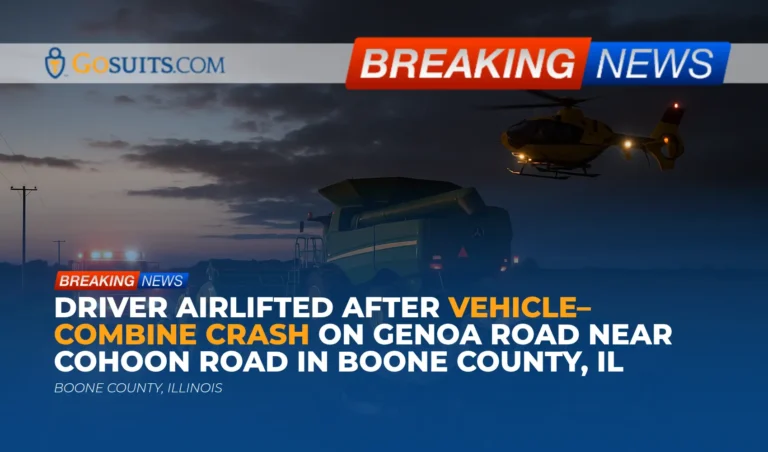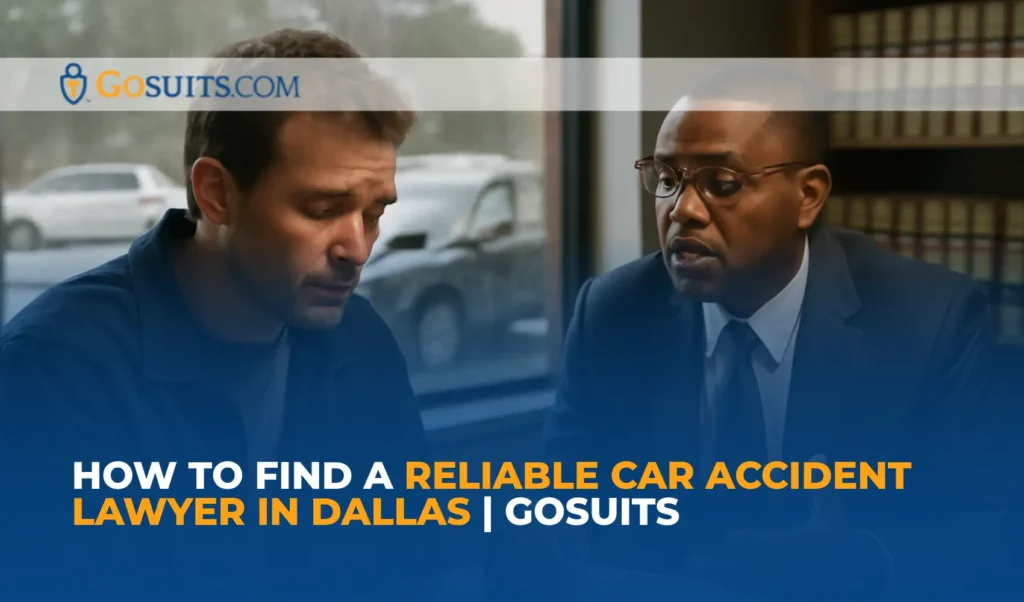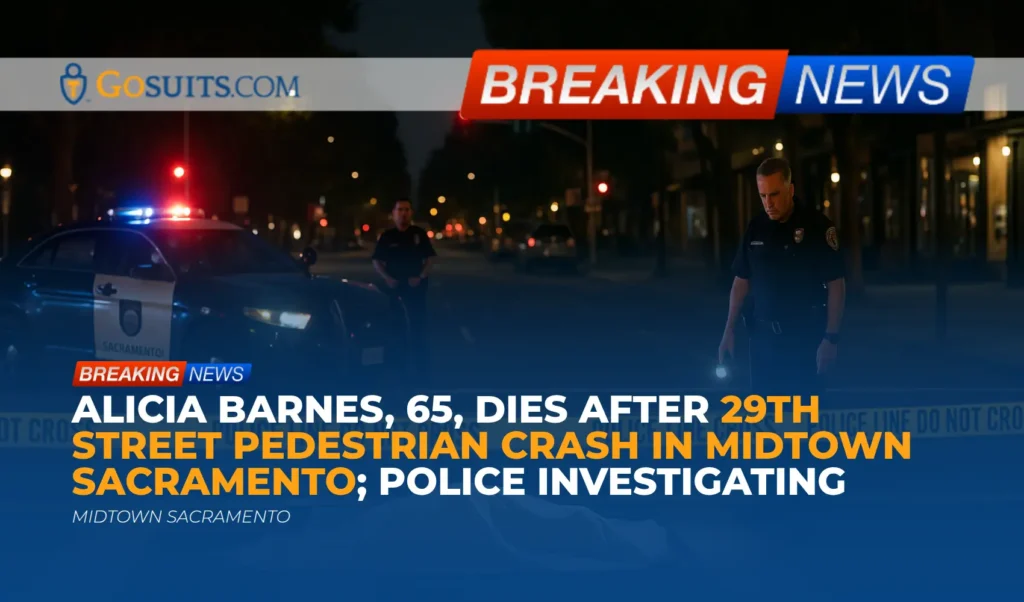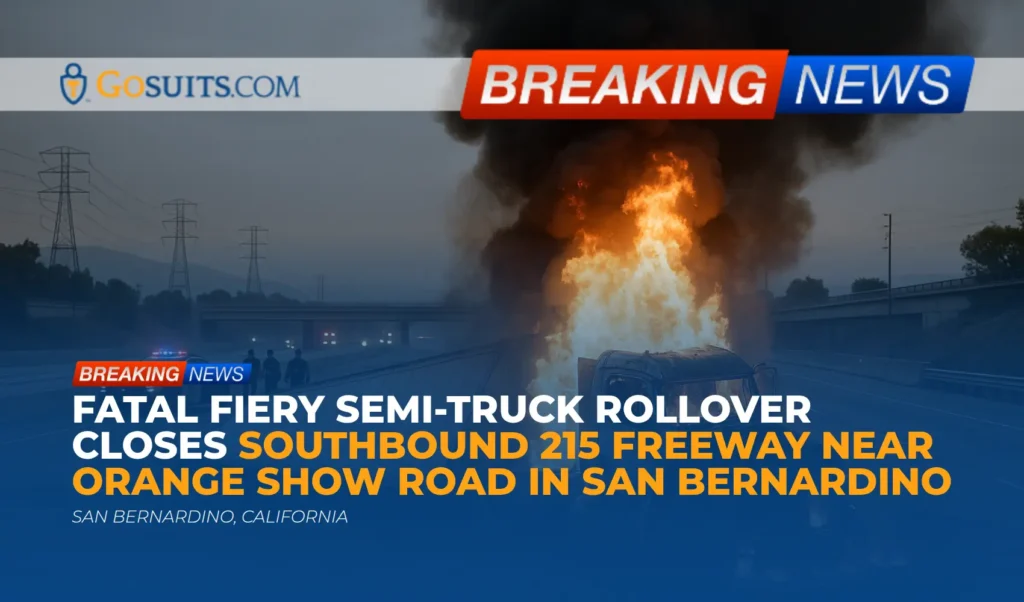- What we know about the Boone County crash on Genoa Road
- Location context and roadway conditions near Genoa Road and Cohoon Road
- Why vehicle–combine collisions happen on public roads
- Potential civil liability after a vehicle–combine collision in Illinois
- Evidence to secure as soon as possible
- Getting official records and where to call in Boone County
- Insurance considerations after a vehicle–combine crash
- Time limits and legal deadlines in Illinois
- Safety reflections for the community during harvest season
- How investigations typically proceed in mixed farm-equipment crashes
- Practical steps people often consider after a serious crash
- Commentary from Gosuits Boone County, Illinois Personal Injury Attorney
- Why timely action matters
What we know about the Boone County crash on Genoa Road
Authorities in Boone County, Illinois responded to a serious crash shortly before 7:30 p.m. on October 1, 2025, on Genoa Road near Cohoon Road. According to initial statements from Boone County Fire Protection District 2 and county deputies, a passenger vehicle and a farm combine collided under circumstances that remain under investigation. Fire crews required approximately 10 to 15 minutes to extricate the vehicle’s driver, who was pinned. That driver was airlifted by a medical helicopter to a nearby hospital. The combine operator reportedly was not injured. Genoa Road was closed for roughly three hours and later reopened. The investigation is ongoing, and no further official details have been released about contributing factors or fault.
Even brief summaries like this make clear how sudden and disruptive these incidents can be for everyone involved. Evening visibility, harvest-season traffic, and the size and operational limits of farm machinery can all play roles in how a crash unfolds, though specific causes in this incident have not been confirmed.
Location context and roadway conditions near Genoa Road and Cohoon Road
Genoa Road is a rural corridor connecting communities and farmland in and around Boone County. During early fall, Illinois roads often see increased agricultural equipment movement between fields and storage sites. Combines and other implements commonly travel at slow speeds, may be wider than standard lanes, and can make wide or unexpected turning maneuvers into field entrances. At dusk or after dark, visibility challenges increase for all drivers.
Illinois transportation and safety agencies regularly emphasize that rural roads can present unique risks. The Illinois Department of Transportation (IDOT) highlights seasonal hazards and encourages both motorists and farm equipment operators to use lighting, reflective markers, and caution when sharing the road during harvest periods. For statewide transportation safety information, visit IDOT.
Why vehicle–combine collisions happen on public roads
Crashes involving agricultural equipment on public roads occur for a range of reasons. While no cause has been identified in this Boone County incident, research and safety guidance from public institutions point to recurring patterns that are helpful for community awareness:
- Speed differentials: Farm equipment typically moves far below posted speed limits. When a motor vehicle approaches at normal speed, closing distances shrink rapidly, reducing reaction time.
- Visibility and conspicuity: Dusk and nighttime conditions, dust from fields, and the sheer size and shape of combines can make them harder to judge at a distance. Illinois guidance stresses proper lighting and reflective slow-moving vehicle markings when farm equipment travels public roads. The Illinois Vehicle Code contains requirements for lighting and slow-moving vehicle identification when operating certain farm equipment on roadways; see the Illinois Vehicle Code at the Illinois General Assembly site here.
- Turning and field entrances: One of the most frequent crash scenarios involves a motor vehicle attempting to pass as farm equipment turns left into a field or driveway. Wide turning radii and limited operator sightlines can complicate these maneuvers. The University of Illinois Extension provides public safety education on sharing the road with farm equipment, including left-turn and passing risks; see University of Illinois Extension.
- Lighting and marking compliance: Proper use of lights, reflectors, and slow-moving vehicle emblems increases visibility. Compliance is a safety issue and a legal one. The Illinois Vehicle Code establishes equipment requirements for roadway operation and identifies slow-moving vehicle rules; consult the code through the Illinois General Assembly’s website above.
- Driver attention and fatigue: Evening driving, glare from oncoming lights, fatigue during harvest season, and distractions in passenger vehicles can all elevate risk. Federal safety agencies warn that nighttime and fatigue-related driving conditions worsen crash outcomes; general roadway safety research is available at NHTSA and CDC/NIOSH Agricultural Safety.
These factors underscore why careful investigation is important. Each crash has its own profile of environmental conditions, vehicles involved, compliance with equipment requirements, and human factors.
Potential civil liability after a vehicle–combine collision in Illinois
Illinois applies fault-based rules to traffic crashes. If a driver or equipment operator failed to exercise reasonable care, civil liability can follow. In mixed vehicle–combine collisions, a careful analysis often considers:
- Lighting, marking, and equipment compliance: Whether the combine or towed equipment displayed required lighting and slow-moving vehicle identification when traveling on a public roadway. Evidence might include photos, body-worn camera footage, and witness statements. The Illinois Vehicle Code lays out general standards for lighting and slow-moving vehicle identification; see the code via the Illinois General Assembly here.
- Lane position and width: Whether the equipment exceeded lane width, used escort vehicles where recommended, or safely negotiated narrow bridges and shoulders. Some roadway segments may require additional caution or routing to avoid undue risk.
- Turning behavior: Whether the farm vehicle signaled and checked for overtaking traffic before turning into a field or driveway, and whether the approaching motorist attempted to pass in a no-passing area or without sufficient distance.
- Speed and following distance: Whether the motor vehicle adjusted speed and following distance upon sighting a slow-moving vehicle emblem or lights ahead.
- Comparative fault: Illinois follows modified comparative negligence. A person who is more than 50 percent at fault is generally barred from recovering damages; if 50 percent or less at fault, recoverable damages are reduced by the percentage of fault. See 735 ILCS 5/2-1116 on the Illinois General Assembly site here.
- Employer or ownership issues: If the combine was operated in the course of farm business, responsibility may extend to the owner or employer under respondeat superior. Insurance structures in agricultural operations vary, and identifying all potentially responsible policies requires diligence.
Each of these questions turns on facts. Photographs, lighting condition assessments, measurements, data from vehicle modules, dispatch records, and agency reports are often necessary to evaluate liability and insurance coverage.
Evidence to secure as soon as possible
Important evidence can disappear quickly after a collision. Where possible, it can help to ensure the following items are located and preserved:
- Scene photos and video: Images of final resting positions, roadway markings, debris fields, lighting, and weather conditions. Dashcam footage from any involved or nearby vehicles can be invaluable.
- Vehicle and equipment inspection: Retain both the passenger vehicle and the combine (and any towed implements) for inspection before repairs or salvage. Photographs of lighting arrays, slow-moving vehicle emblems, reflectors, and any damage to these components should be secured.
- Electronic data: Modern passenger vehicles may store crash data in event data recorders. Some agricultural equipment may log operational parameters. Preservation letters can help prevent loss of relevant digital data.
- Witness information: Names and contact details for anyone who saw the crash, the vehicles’ movements, or the immediate aftermath.
- Dispatch and 911 records: Audio, CAD logs, and response timelines from the relevant dispatch center can clarify chronology.
- Medical documentation: All emergency care records, imaging, diagnoses, and treatment plans are essential to understand injuries and future needs.
Because statements to insurance adjusters may be recorded and can be used to contest liability or injuries later, it is generally wise for an injured person to consult with a qualified attorney before speaking with any insurance company about the crash.
Getting official records and where to call in Boone County
Several agencies may hold records relevant to this crash type. Availability depends on the status of the investigation and privacy laws. In Illinois, many public records are available through the Freedom of Information Act (FOIA). The Illinois Attorney General provides general FOIA guidance here.
Law enforcement crash report
Depending on the responding agency, the primary crash report will be prepared by the Boone County Sheriff’s Office or another jurisdiction with authority at the scene. Requests typically include the date, time, location, and names of involved parties if known.
- Where to start: Boone County’s official site provides department contact information and FOIA procedures. Visit Boone County, Illinois and navigate to the Sheriff’s Office and FOIA pages for instructions.
- State police involvement: If the Illinois State Police responded or assisted, statewide information and district contacts can be found at Illinois State Police. Requests for ISP reports follow their published procedures.
Fire department incident report
Extrication details, response times, and scene observations by fire personnel may be recorded in a fire incident report. For this crash, Boone County Fire Protection District 2 reported the extrication and airlift.
- Where to start: Look for Boone County or the fire protection district’s official contact pages via Boone County. Fire reports may be requested through the district’s administrative office or the county’s FOIA process.
Coroner and medical records
When a fatality occurs, the county coroner may investigate and issue an autopsy report, death certificate, and toxicology findings, subject to statutory rules regarding release. In non-fatal incidents, medical records are obtained from hospitals and providers directly by the patient or authorized representative.
- Coroner: The Boone County Coroner’s Office information and request procedures can be found through the county’s main site at Boone County, Illinois.
- Medical records: Hospitals provide records through their Health Information Management departments upon completion of the necessary authorization forms under HIPAA and Illinois law.

911 audio and dispatch logs
Recorded 911 calls, radio traffic, and computer-aided dispatch logs can clarify timing and scene details. Availability can depend on retention policies and investigation status, so requests should be made promptly.
- Where to start: Contact the county or regional dispatch center through county government pages at Boone County. FOIA may apply, with necessary redactions to protect private information.
Roadway and traffic-control records
Road design, signage, speed limits, and maintenance records may be relevant if roadway conditions contributed to the crash. Seasonal advisories sometimes apply during harvest.
- Where to start: For county-maintained roads, contact Boone County Highway Department via Boone County. For state routes, IDOT provides contact information and public records processes at IDOT.
Insurance considerations after a vehicle–combine crash
Coverage can be complex when agricultural equipment is involved. Multiple policies may apply, and coverage questions should be explored early:
- Auto liability: If a motorist is alleged to be at fault, the motorist’s auto liability policy is implicated. If the combine operator or the farm entity is alleged to be at fault, a farm or commercial policy may apply.
- Farm/commercial policies: Agricultural operations often carry general liability and umbrella coverage, and some have endorsements specifically addressing roadway use of equipment.
- Uninsured/underinsured motorist (UM/UIM): If fault lies with a party who lacks adequate insurance, the injured person’s own UM/UIM coverage may provide benefits.
- Medical payments (MedPay): Some auto policies provide no-fault medical payments coverage to help with initial medical expenses.
- Workers’ compensation: If someone was injured in the course of employment, workers’ compensation may also be relevant.
Before speaking with any insurance company, it is prudent for an injured person to consult with an attorney. Adjusters may request recorded statements, authorizations, or quick settlements. What is said early can be used later to challenge liability or minimize injuries. A free consultation can help clarify rights, available coverage, and the best sequence of steps.
Time limits and legal deadlines in Illinois
Illinois law places time limits on bringing civil claims:
- Personal injury claims: Generally two years from the date of injury. See 735 ILCS 5/13-202 on the Illinois General Assembly website here.
- Claims against local public entities: Some claims must be brought within one year. See 745 ILCS 10/8-101 in the Local Governmental and Governmental Employees Tort Immunity Act here.
- Property damage claims: Often have different timelines under Illinois law.
Other deadlines may apply, including insurance policy notice requirements and preservation letters. Because deadlines can vary based on the parties involved and the specific claims, timely legal guidance can help prevent the loss of important rights.
Safety reflections for the community during harvest season
During harvest, rural roads see more slow-moving equipment. Public institutions offer safety recommendations that can reduce risk for everyone:
- For motorists: Reduce speed immediately upon sight of a slow-moving vehicle emblem or flashing amber lights. Keep a safe following distance and be patient; wait to pass until legal and clearly safe. Night driving requires extra care.
- For farm operators: Verify all required lighting and slow-moving vehicle emblems are installed, clean, and visible. Use turn signals well in advance, check mirrors frequently, and consider escort vehicles where appropriate for width or visibility concerns. University of Illinois Extension provides roadway safety resources for farm operations; see University of Illinois Extension.
- For planners and agencies: Monitor signage and pavement markings in areas with heavy farm traffic, and consider seasonal advisories or temporary signage where warranted. See general statewide roadway safety information from IDOT.
Shared awareness can reduce the chance of severe injuries and help ensure that everyone returns home safely.
How investigations typically proceed in mixed farm-equipment crashes
After a collision like the one on Genoa Road, agencies typically perform several tasks:
- Scene documentation: Officers document vehicle positions, skid or yaw marks, debris fields, and roadway geometry. Photographs and measurements support later analysis.
- Vehicle inspection: Investigators may examine lighting, reflectors, slow-moving vehicle emblems, and signal functions on the combine and any towed equipment, along with damage profiles on all vehicles.
- Interviews and statements: Drivers, occupants, and witnesses describe their observations. Times of day, visibility, and traffic flow are noted.
- Supplemental data: 911 recordings, dispatch logs, and medical records provide a timeline of events and outcomes.
- Reconstruction: For significant crashes, reconstruction may analyze speeds, perception-reaction time, sight distances, and conspicuity. Findings can inform liability and safety recommendations.
Because this Boone County incident remains under investigation, official findings have not yet been released.
Practical steps people often consider after a serious crash
In the wake of a serious injury crash, people often feel overwhelmed. The following steps are commonly considered to protect safety, health, and legal rights:
- Get medical care and follow-up: Emergency treatment comes first. Follow all medical advice, attend follow-up appointments, and keep copies of discharge summaries, imaging, and prescriptions.
- Preserve evidence: Photograph vehicles and the scene, secure dashcam footage, and request that all vehicles and equipment be preserved until a thorough inspection can occur.
- Request official records: Seek the crash report, fire incident report, and dispatch records through the county’s channels. Use the FOIA guidance provided by the Illinois Attorney General at this link.
- Consult an attorney before speaking to insurers: Before giving any recorded statement or signing authorizations, consider a free consultation with a qualified attorney. Insurers evaluate and sometimes challenge liability and injuries, and early statements can be used later.
- Track expenses and impacts: Maintain a log of medical costs, time away from work, travel to appointments, and day-to-day impacts. This documentation can be important in claim evaluations.
- Mind the deadlines: Illinois law imposes time limits on claims. Acting promptly helps ensure critical evidence is not lost and timelines are met. See the statute of limitations links above.
Commentary from Gosuits Boone County, Illinois Personal Injury Attorney
Our thoughts are with everyone affected by the crash on Genoa Road. Being airlifted after a collision is frightening, and the suddenness of such events is hard on families and communities. This overview is shared for educational and general information purposes and is not a substitute for personalized guidance.
Vehicle–combine collisions raise unique questions. Visibility at or after dusk, the conspicuity of slow-moving equipment, and turning movements into field entrances are all common flashpoints. Determining whether proper lighting and slow-moving vehicle identification were in place, and whether passing or turning occurred safely, usually requires careful review of physical evidence, reports, and witness accounts. In many rural crashes, both motorist expectations and operator duties are scrutinized under Illinois’ comparative negligence rules. Thorough, early preservation of evidence often makes the difference in clarifying what happened.
Insurance companies and corporate entities involved in agricultural operations have structured processes aimed at minimizing payouts. Adjusters may seek recorded statements soon after the crash and request broad medical authorizations. These steps can shift narratives and limit claim values. Without guidance, many people do not realize how simple, well-intentioned statements can be interpreted against them months later. It is generally wise to speak with a seasoned attorney first, understand the coverages at stake, and develop a plan before engaging with any insurance representative.
A free consultation can help map the landscape: which policies may apply, how to preserve evidence, what deadlines control, and how to safely handle communications. Even if no claim is ultimately pursued, early clarity can prevent costly missteps.

Why timely action matters
Acting promptly after a serious roadway crash can protect health, preserve evidence, and keep legal options open. Consider the following time-sensitive steps:
- Prioritize medical evaluation: Immediate and follow-up care creates a clear record of injuries and ensures appropriate treatment. Some injuries worsen if not identified early.
- Secure vehicles and equipment: Arranging for both the passenger vehicle and the combine to be held for inspection helps ensure lighting, marking, and mechanical conditions can be evaluated before repairs, scrapping, or weather erase crucial details.
- Request reports and records early: Crash reports, fire incident summaries, and dispatch recordings may have processing times or retention limits. Early requests reduce the risk of loss and create a solid timeline.
- Avoid recorded statements until after legal consultation: Insurance representatives may ask for statements within days. Consult an attorney first to understand rights and potential implications; what is said can be used later.
- Document everything: Collect bills, receipts, and notes about pain levels, missed work, and daily limitations. Thorough documentation supports accurate evaluations of needs.
- Calendar legal deadlines: Illinois statutes of limitations and, in some cases, shorter deadlines for claims involving public entities can significantly affect options. Early attention to timelines prevents forfeiture of claims.
Taking these steps quickly can help ensure that critical facts are captured, health needs are addressed, and pathways for recovery remain available.
Reliable public resources referenced
- Boone County, Illinois (official county site)
- Illinois State Police
- Illinois Department of Transportation
- Illinois Attorney General FOIA Guidance
- Illinois Vehicle Code (Illinois General Assembly)
- 735 ILCS 5/2-1116 Comparative Fault
- 735 ILCS 5/13-202 Statute of Limitations
- 745 ILCS 10/8-101 Claims Against Local Public Entities
- University of Illinois Extension (roadway safety with farm equipment)
- National Highway Traffic Safety Administration
- CDC/NIOSH Agricultural Safety






